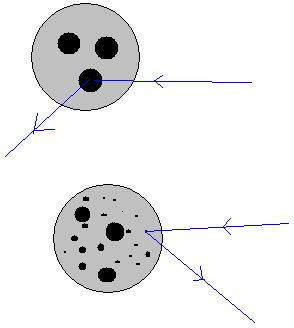 | ||
In particle physics, the parton model is a model of hadrons, such as protons and neutrons, proposed by Richard Feynman. It is useful for interpreting the cascades of radiation (a parton shower) produced from QCD processes and interactions in high-energy particle collisions.
Contents
Model
Parton showers are simulated extensively in Monte Carlo event generators, in order to calibrate and interpret (and thus understand) processes in collider experiments. As such, the name is also used to refer to algorithms that approximate or simulate the process.
Motivation
The parton model was proposed at Cambridge University by Richard Feynman in 1969 as a way to analyze high-energy hadron collisions. Any hadron (for example, a proton) can be considered a composition of a number of point-like constituents, termed "partons". The parton model was immediately applied to electron-proton deep inelastic scattering by Bjorken and Paschos.
Component particles
A hadron is composed of a number of point-like constituents, termed "partons". Later, with the experimental observation of Bjorken scaling, the validation of the quark model, and the confirmation of asymptotic freedom in quantum chromodynamics, partons were matched to quarks and gluons. The parton model remains a justifiable approximation at high energies, and others have extended the theory over the years.
Just as accelerated electric charges emit QED radiation (photons), the accelerated coloured partons will emit QCD radiation in the form of gluons. Unlike the uncharged photons, the gluons themselves carry colour charges and can therefore emit further radiation, leading to parton showers.
Reference frame
The hadron is defined in a reference frame where it has infinite momentum — a valid approximation at high energies. Thus, parton motion is slowed by time dilation, and the hadron charge distribution is Lorentz-contracted, so incoming particles will be scattered "instantaneously and incoherently".
Partons are defined with respect to a physical scale (as probed by the inverse of the momentum transfer). For instance, a quark parton at one length scale can turn out to be a superposition of a quark parton state with a quark parton and a gluon parton state together with other states with more partons at a smaller length scale. Similarly, a gluon parton at one scale can resolve into a superposition of a gluon parton state, a gluon parton and quark-antiquark partons state and other multiparton states. Because of this, the number of partons in a hadron actually goes up with momentum transfer. At low energies (i.e. large length scales), a baryon contains three valence partons (quarks) and a meson contains two valence partons (a quark and an antiquark parton). At higher energies, however, observations show sea partons (nonvalence partons) in addition to valence partons.
History
The parton model was proposed by Richard Feynman in 1969, used originally for analysis of high-energy collisions. It was immediately applied to electron/proton deep inelastic scattering by Bjorken and Paschos. Later, with the experimental observation of Bjorken scaling, the validation of the quark model, and the confirmation of asymptotic freedom in quantum chromodynamics, partons were matched to quarks and gluons. The parton model remains a justifiable approximation at high energies, and others have extended the theory over the years.
It was recognized that partons describe the same objects now more commonly referred to as quarks and gluons. A more detailed presentation of the properties and physical theories pertaining indirectly to partons can be found under quarks.
Parton distribution functions
A parton distribution function within so called collinear factorization is defined as the probability density for finding a particle with a certain longitudinal momentum fraction x at resolution scale Q2. Because of the inherent non-perturbative nature of partons which can not be observed as free particles, parton densities cannot be fully obtained by perturbative QCD. Within QCD one can, however, study variation of parton density with resolution scale provided by external probe. Such scale is for instance provided by a virtual photon with virtuality Q2 or by a jet. Due to the limitations in present lattice QCD calculations, the known parton distribution functions are instead obtained by fitting observables to experimental data.
Experimentally determined parton distribution functions are available from various groups worldwide. The major unpolarized data sets are:
The LHAPDF library provides a unified and easy-to-use Fortran/C++ interface to all major PDF sets.
Generalized parton distributions (GPDs) are a more recent approach to better understand hadron structure by representing the parton distributions as functions of more variables, such as the transverse momentum and spin of the parton. Early names included "non-forward", "non-diagonal" or "skewed" parton distributions. They are accessed through exclusive processes for which all particles are detected in the final state. Ordinary parton distribution functions are recovered by setting to zero (forward limit) the extra variables in the generalized parton distributions. Other rules show that the electric form factor, the magnetic form factor, or even the form factors associated to the energy-momentum tensor are also included in the GPDs. A full 3-dimensional image of partons inside hadrons can also be obtained from GPDs.
Simulation
Parton showers simulations are of use in computational particle physics either in automatic calculation of particle interaction or decay or event generators, and are particularly important in LHC phenomenology, where they are usually explored using Monte Carlo simulation. The scale at which partons are given to hadronization is fixed by the Shower Monte Carlo program. Common choices of Shower Monte Carlo are PYTHIA and HERWIG.
